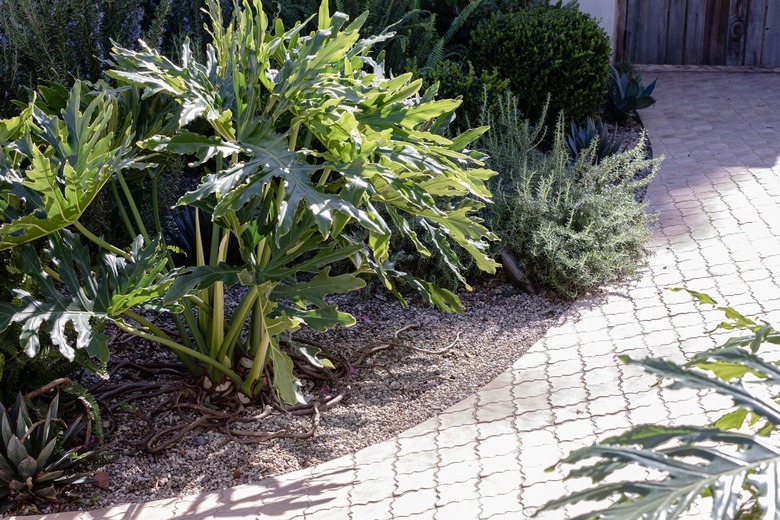What Is Xeriscape?
We may receive a commission on purchases made from links.
A xeriscape is a style of landscaping that doesn't require a lot of water use to maintain. It also tends to be more low maintenance than many other types of traditional landscaping. Xeriscapes are crafted around seven simple design principles, and they can look very appealing. This type of landscaping is popular in areas where the climate is dry but can be found in other places as well.
Want to start xeriscape landscaping? Learn what it is, and how to maintain a xeriscape yard.
Is It Xeriscape or Zeroscape?
Is It Xeriscape or Zeroscape?
The term "xēros" is the Greek word for "dry," and the term "xeriscape" was first used by Denver, Colorado's water utility, Denver Water, in the 1980s. Sometimes, however, when people hear the word "xeriscape," they think of a barren, rock-filled or gravely area that is mostly devoid of plants. This has sometimes been referred to as "zeroscaping," which pokes fun at this landscape design as a hands-off way to avoid lawn care and eliminate as much of the yard maintenance as possible. Most people don't use this term in a positive light, and this type of design is not what xeriscaping is about.
But contrary to what some believe, successful xeriscapes can actually be very colorful and attractive. There are a vast number of different plants that can work well in this type of design, and the layout is thoughtfully considered so as to add appeal to the home. It isn't an afterthought or a one-and-done type of approach but rather a conscious plan for using the natural landscape blended with plants that don't consume large amounts of water. While not for everyone, this type of landscape design can be very attractive to certain homeowners.
Where to Plant a Xeriscape Yard
Where to Plant a Xeriscape Yard
A xeriscape landscape design performs very well for those living in a climate where it's difficult to grow or maintain a traditional lawn or plantings that require a great deal of watering. Xeriscapes are a good match for arid climates or for areas that have a lot of variation in weather. This is one of the reasons they are often found in places such as:
- Colorado (specifically in the Denver region)
- Arizona
- California
- New Mexico
- Nevada
However, they are by no means restricted to these places and can work well anywhere with a little planning. Xeriscapes can be created in all shapes and sizes and are extremely easy to customize. Whether it's a small patch of side yard, a large backyard or a shady area under trees, there's a xeriscape landscape design that will work for the space.
Primary Features of a Xeriscape
Primary Features of a Xeriscape
Although the exact features of a xeriscape garden or landscape can vary, the main centerpiece is water conservation and water usage. Drought-tolerant plants are the core features around which xeriscapes are built. While these don't have to be native plants, if they are, they'll require less soil amendment, as the plants will grow well naturally. Although the word "xeriscape" can bring to mind images of a cactus, other examples of these plants include lavender, agave, juniper, and oregano. What is native depends on the region.
Thoughtful irrigation is another key xeriscape feature, and this works hand in hand with mulch to keep plants from drying out. Mulching cuts down on the overall water needs in planted areas, and it also helps to reduce weed growth, thus helping reduce maintenance for the homeowner. A good layer of mulch also helps to protect soil from the drying effects of wind and sun.
Drip irrigation is a great targeted water conservation tool, as it gets the water where it needs to go rather than spraying it all over like a rotating sprinkler. Once wet, the mulch keeps the ground from drying out quickly. While rocks and stone are often used in xeriscapes, they tend to retain heat, so the location and amount of these items should be chosen thoughtfully.
How to Maintain a Xeriscape
How to Maintain a Xeriscape
Although a xeriscape design can result in a more low-maintenance yard than a traditional lawn or other landscape designs, it is not completely hands-off. Even through heavy mulch, weeds will sometimes pop up, and some plants may benefit from an occasional pruning or will need to be cut back at certain times of the year. A lot of this depends on the type of plants chosen, so it pays to research these before finalizing a plan.
Also, keep in mind that even plants that don't need a lot of moisture will still require some extra watering and tending until they are well-established, or during periods of drought, so be sure to plan accordingly. It's also helpful to group together plants with similar watering needs to help with water conservation efforts and ease of care.
